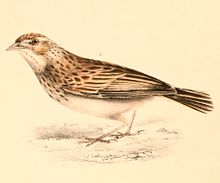Melodious lark
| Melodious lark | |
|---|---|

| |
| Scientific classification | |
| Kingdom: | |
| Phylum: | |
| Class: | |
| Order: | |
| Family: | |
| Genus: | |
| Species: | M. cheniana
|
| Binomial name | |
| Mirafra cheniana Smith, 1843
| |

| |
| range | |
The melodious lark or Latakoo lark (Mirafra cheniana) is a species of lark in the Alaudidae family, that is currently threatened by habitat loss.
Range and population
The species as a whole has, perhaps, a maximum range of 110,400 square kilometres (42,600 sq mi), but this is something of a tattered web; small, isolated communities are strewn primarily about parts of South Africa (Eastern Cape, and the Free State), with fewer still in Botswana and Zimbabwe, and have limited opportunities for social interaction with each other.[2]
Gauteng, KwaZulu-Natal, Limpopo, and North West Province also have patches in Mirafra cheniana's fragmented range.[2]
Ecology
Habitat
Generally speaking, the natural habitat of M. cheniana is subtropical or tropical, seasonally wet or flooded, lowland grassland.[2]
Within these regions, however, M. cheniana prefers life on the dryer slopes, such as there are, especially in open runs between grassy tussocks. It tends to avoid lower areas where vegetation grows taller and more densely, and precipitation collects, making it moister.[2]
Breeding and nesting
M. cheniana is probably territorial and monogamous, and lays a clutch of 2-4 eggs.[2]
It is generally resident, breeding throughout the months of September through March. The level of breeding activity varies somewhat depending on locality; in South Africa, the most active period is November through January, while in Zimbabwe it is January through March.[2]
Otherwise, however, local communities are compelled to abandon one area for another when regular dry-season fires occur, though on any given year this may affect certain colonies while missing others.[2]
M. cheniana select different textures of grass or grass parts to build their domed, obliquely-accessed nests. They use the harder, and more fibrous grasses and stalks for an outer thatch, while the finer and softer grasses or grass leaves are used to line the nest's interior.[2]
Diet
M. cheniana forages on the land, eating mostly grass seeds, supplemented somewhat with insects.[2]
References
- ^ Template:IUCN
- ^ a b c d e f g h i Compilers: Andrew O'Brien, Joe Taylor (2008). "Melodious Lark - BirdLife Species Factsheet". Evaluators: Stuart Butchart, Joe Taylor. BirdLife International . Retrieved May 11, 2009.
{{cite web}}: CS1 maint: extra punctuation (link)
External links
- Melodious lark - Species text in The Atlas of Southern African Birds.

